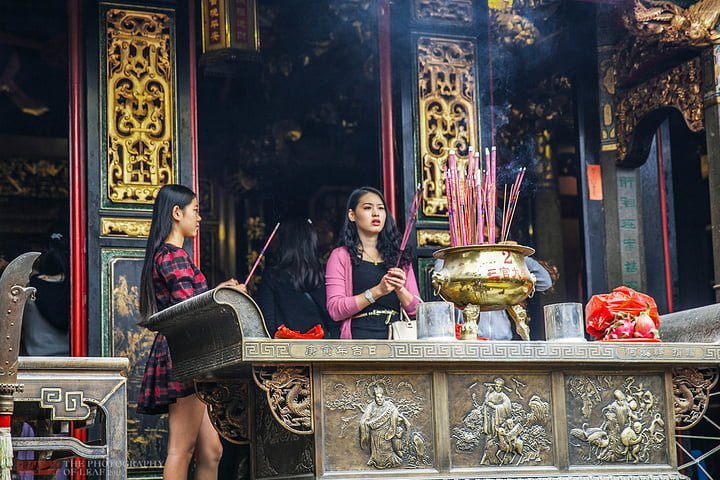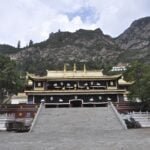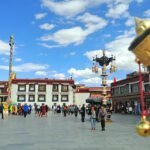Explore the intriguing Guan Yu Temple in Lhasa, a unique symbol of cultural integration and religious diversity in Tibet. Nestled atop Mountain Pamari, this temple exemplifies the rich historical tapestry of Lhasa and its unique blend of Tibetan and Han Chinese cultures.
Historical Significance of Guan Yu Temple
- Qing Dynasty’s Historical Expedition: In 1793, under the Qing Dynasty, General Fukang’an led a victorious campaign against the Gorkhas in Tibet. Post-victory, the general, attributing his success to the spiritual guidance of Han General Guan Yu, decided to establish a temple in his honour.
- Construction and Funding: The temple, funded by 7,000 taels of silver raised by the army and the Prince Regent, stands as a tribute to the legendary general known for his valour during the Three Kingdoms period (220-280).
Guan Yu and Tibetan Culture
- Gesar Lhakang: The temple is also known as Gesar Lhakang, drawing a parallel between Guan Yu and King Gesar, a heroic figure in Tibetan folklore. This association highlights the cultural reverence for bravery and heroism across different traditions.
- Tibetan Religious Practices: The temple has been a centre for Tibetan divination practices for over two centuries. Devotees often bring chickens for release, a practice that symbolizes liberation and spiritual cleansing.

The Legacy of Guan Yu
- Iconic Weaponry: Guan Yu’s legendary weapon, the “Green Dragon Crescent Moon Blade,” a guan dao resembling a medieval halberd and weighing about 41 kilograms (90 pounds), is a significant part of his lore and is often depicted in artistic representations.
Visiting the Guan Yu Temple
- A Must-See Destination: For visitors to Lhasa, the Guan Yu Temple offers a unique glimpse into the integration of different cultural beliefs and practices. It stands not only as a religious site but also as a beacon of historical and cultural fusion.
- Experience Cultural Harmony: The temple is a testament to the harmonious coexistence of diverse cultural narratives, making it an essential destination for those interested in the rich heritage of Tibet.
The Guan Yu Temple in Lhasa is more than a religious landmark; it’s a living symbol of the confluence of Tibetan and Han Chinese cultures. Its historical significance, combined with the unique cultural practices observed here, makes it a fascinating site for history buffs, cultural enthusiasts, and spiritual seekers alike.
Unveiling the Mystique of Lhasa’s Guandi Temple: A Cultural Convergence
Discover the historical and architectural marvel of the Guandi Temple in Lhasa, a testament to the harmonious blend of Tibetan and Han Chinese cultures. This temple, nestled on Mopanshan, stands as a symbol of unity and spiritual reverence, attracting history enthusiasts and cultural explorers.
The North Gate: A Tibetan Architectural Gem
- Traditional Design: The north gate of Guandi Temple, facing Beijing Middle Road, is a masterpiece of Tibetan-style architecture. The red gate, embellished with large cannon nails, not only serves a decorative purpose but also strengthens the structure.
- Visitor-Friendly Entrance: A small lug on the right door panel allows easy access for tourists, maintaining the sanctity and simplicity of the temple with no commercial distractions like ticket sales.
A Rich Historical Legacy at the Gatehouse
- Bilingual Inscription: A prominent stone tablet beside the gatehouse, inscribed in both Tibetan and Chinese, declares the temple as a key cultural relic of Lhasa City, underlining its historical significance since its establishment by the People’s Government of the Tibet Autonomous Region in 2007.
The South Gate: The Main Entrance to History
- Scenic Approach: The south gate, serving as the main entrance, leads to a parking area akin to a basketball court’s size, setting the stage for the temple’s impressive mountain-backed architecture.
The Serene Ambiance of Guandi Temple
- Unique Atmosphere: Contrary to the grandeur of the Potala Palace or the lively scenes of the Jokhang Temple, the Guandi Temple exudes a tranquil and pure vibe, offering a contemplative escape in the heart of Lhasa.
Exploring the Temple’s Natural and Architectural Splendor
- The Path to Tranquility: A walk up the moss-covered stone steps, surrounded by tall, green trees, leads to the temple courtyard, offering a refreshing and serene experience.
- Symbolic Courtyard Gate Plaque: The plaque, inscribed with “Eternal Peace in the Western Regions” in Tibetan and Chinese, is a striking feature, symbolizing the temple’s deep-rooted cultural and historical importance.
Cultural Integration and Unity in Guandi Temple
- A Testament to Unity: The temple’s plaques and inscriptions echo the sentiments of unity and stability in Tibetan areas, reflecting the deep integration of Tibetan and Chinese cultures.
Inside Guandi Temple: A Journey Through Time
- Architectural Layers: The temple showcases a classic Chinese-style structure, spread across three levels, with each step holding a story of its own.
- Courtyard’s Historical Relics: The courtyard, with its two-story Tibetan buildings, is a repository of cultural and historical artefacts, including a monument commemorating the temple’s completion.
Preserving the Legacy of Guandi Temple
- The Qing Stele: Standing as a historical record, the Qing stele in the temple courtyard narrates the story of the Qing army’s victory over the Gorkha invasion, marking a significant event in the temple’s history.
The Guandi Temple in Lhasa is more than just a religious site; it’s a beacon of cultural harmony and historical richness. Its serene environment, coupled with a wealth of architectural and historical elements, makes it an essential destination for those seeking to immerse themselves in the diverse heritage of Lhasa.
















